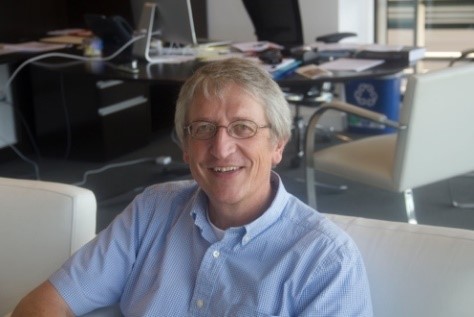Polymer-Acceptor Bulk Heterojunction Solar Cells: From Chemical Structure to Packing and Efficiency
Abstract
The morphology of the active layer of a bulk heterojunction (BHJ) solar cell, made of a blend of an electron-donating polymer and an electron-accepting fullerene or nonfullerene derivative, is known to play a determining role in the performance of organic solar cells.
After a broad introduction, we first describe –on the basis of results from molecular dynamics simulations and long-range corrected density functional theory calculations: (i) the nature of the binding interactions at the donor–acceptor interfaces; (ii) the molecular-level packing in the pure phases as well as at these interfaces; and (iii) the impact of the system dynamics on the interfacial electronic structure.
We then discuss how even minor changes in the chemical structure of the polymer backbone have been shown experimentally to change substantially the blend morphology and the resulting solar-cell efficiency. Taking a series of representative systems based on benzothiadiazole-quaterthiophene polymers and PC71BM, we elucidate the impact of the chemical changes on the ″local″ morphology. We focus on the extent of polymer-fullerene mixing, on their packing, and on the characteristics of the fullerene-fullerene connecting network in the mixed regions, which are all aspects that are difficult to access experimentally. We are able to rationalize the evolutions in power conversion efficiencies within the polymer series.
Finally, we address some of the peculiarities observed in the PIPCP-fullerene blends.
This work is supported by the Office of Naval Research, namely in the framework of the MURI Center on Advanced Organic Photovoltaics.
Biosketch

Jean-Luc Bredas received his Ph.D. from the University of Namur, Belgium, in 1979. In 1988, he was appointed Professor at the University of Mons, Belgium, where he established the Laboratory for Chemistry of Novel Materials. While keeping an “Extraordinary Professorship” appointment in Mons, he joined the University of Arizona in 1999 before moving in 2003 to the Georgia Institute of Technology. In July 2014, he took a 2-½ leave of absence to King Abdullah University of Science and Technology (KAUST) where he served as Distinguished Professor of Materials Science and Engineering and Director of the KAUST Solar and Photovoltaics Research and Engineering Center. At Georgia Tech, where he resumed his activities in January 2017, he is Regents’ Professor of Chemistry and Biochemistry and holds the Vasser-Woolley and Georgia Research Alliance Chair in Molecular Design. He is a Georgia Research Alliance Eminent Scholar since 2005.
Jean-Luc Bredas is a Member of the International Academy of Quantum Molecular Science, the Royal Academy of Belgium, and the European Academy of Sciences. He is the recipient of the 1997 Francqui Prize, the 2000 Quinquennial Prize of the Belgian National Science Foundation, the 2001 Italgas Prize, the 2003 Descartes Prize of the European Union, the 2010 Charles H. Stone Award of the American Chemical Society, the 2013 David Adler Award in Materials Physics of the American Physical Society, and the 2016 Award in the Chemistry of Materials of the American Chemical Society. He is a Fellow of the American Chemical Society (Inaugural Class of 2009), American Physical Society, Optical Society of America, Royal Society of Chemistry, and Materials Research Society (Inaugural Class of 2008), and an Honorary Professor of the Institute of Chemistry of the Chinese Academy of Sciences. He holds honorary degrees from the University of Linköping, Sweden, and the Free University of Brussels. He has published over 1,000 refereed articles (that have garnered over 70,000 citations, leading to a current Web of Science h-index of 121) and given over 500 invited presentations. Since 2008, he has served as Editor for “Chemistry of Materials”, published by the American Chemical Society.
His research interests focus on the computational characterization and design of novel organic materials for organic electronics and photonics.




